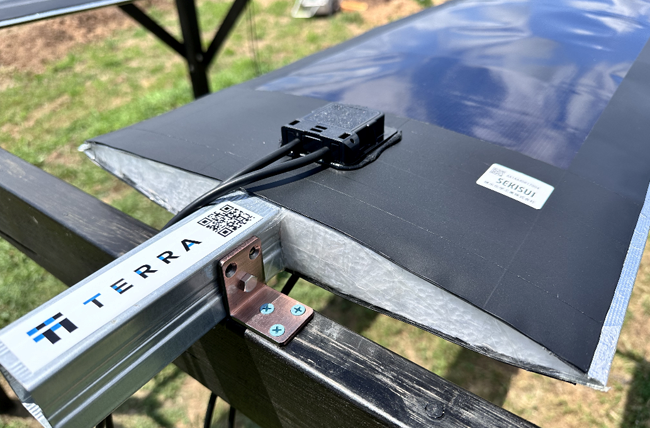Japan-based Sekisui Chemical, a developer of a roll-to-roll process for manufacturing perovskite PV panels, announced an agrivoltaic project in partnership with Terra, an engineering, procurement, and construction (EPC) contractor and a unit of Japan-based Citizen Energy Chiba.
Sekisui announced that the project’s perovskite modules will be based on its 30 cm-wide films made in a roll-to-roll manufacturing process and its sealing, film formation, materials and process technology. The Sekisui perovskite solar devices reportedly have 10 years equivalent of outdoor durability and 15% power conversion efficiency. The company said it is currently working on improving durability and power generation efficiency, as well as scaling up to web widths of 1 m.
The modules have a convex lens-shaped cross-section and are based on a design from Terra, which has rights to relevant patents held by Citizen Energy Chiba. The novel modules are part of a lighter-weight system meant to provide wind load and center of gravity balancing without adding the extra weight that would be required with conventional modules, according to the manufacturer.
Both the module design and the “ultra-slim” mounting and anchoring method from Terra will be validated over the duration of the project. Performance data as well as crop data will also be collected, verified, and compared with predicted values.
Agrivoltaics, which is also referred to in Japan as “solar sharing”, is a specialty of Terra, according to the project team. Its plans include testing agrivoltaics with a variety of crops in Japan, including paddy fields, as well as field tests on idle and abandoned agricultural land.

This content is protected by copyright and may not be reused. If you want to cooperate with us and would like to reuse some of our content, please contact: editors@pv-magazine.com.



By submitting this form you agree to pv magazine using your data for the purposes of publishing your comment.
Your personal data will only be disclosed or otherwise transmitted to third parties for the purposes of spam filtering or if this is necessary for technical maintenance of the website. Any other transfer to third parties will not take place unless this is justified on the basis of applicable data protection regulations or if pv magazine is legally obliged to do so.
You may revoke this consent at any time with effect for the future, in which case your personal data will be deleted immediately. Otherwise, your data will be deleted if pv magazine has processed your request or the purpose of data storage is fulfilled.
Further information on data privacy can be found in our Data Protection Policy.